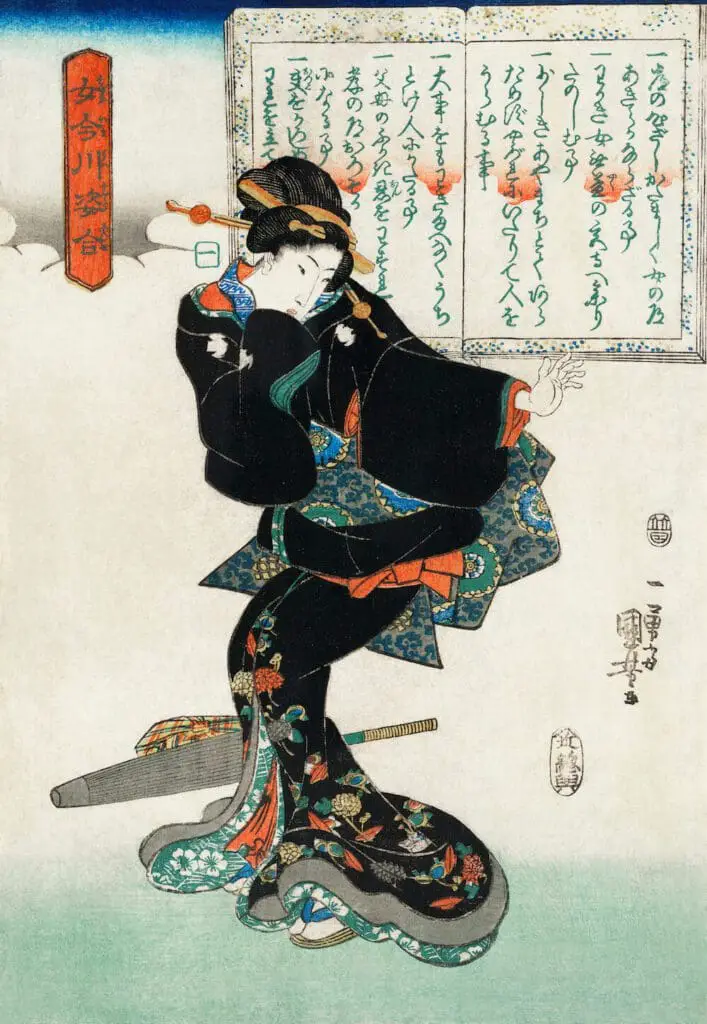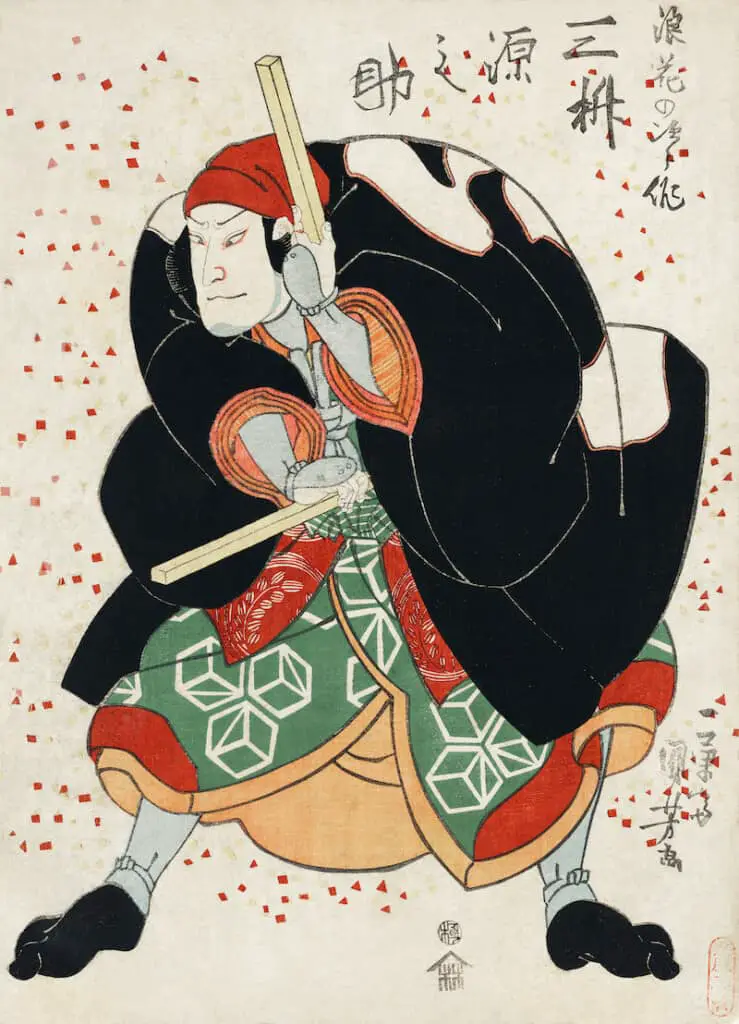One of Japan’s most interesting artistic styles is the Ukiyo-e woodblock prints style. Even today, the Japanese woodblock prints are considered beautiful and relevant.
The Japanese Ukiyo-e woodblock print art style flourished during the Edo Period 1615- 1868. The Shoguns ruled Japan’s social hierarchy. Merchants had money but no political power; they discovered they could be on an equal social footing through art and culture. The Ukiyo-e art style helped give the merchants and others a voice in society. To really understand why the Japanese Ukiyo-e style of woodblock art flourished during the time, it is good to understand what was happening during this era.
Table of Contents
- Flourishing Period of Ukiyo-E Woodblock Art in Japan
- Ukiyo-e Art – The Floating World of Japanese Woodblock Prints
- Frequently Asked Questions
- Related Content

Flourishing Period of Ukiyo-E Woodblock Art in Japan
Ukiyo-e art flourished in Japan during the Tokugawa or Edo Period from 1615-1868. The Tokugawa period was also known as the Edo period, the time in Japan’s history when the Shoguns ruled Japan. The Shogun rule of Japan was relatively peaceful, so art flourished.
Important Historical Background Of Ukiyo-e Woodblock Prints
Here is some important historical background about the Ukiyo-e art period under the Edo rule from 1615 to 1868:
Social Hierarchy –
The Japanese Shogun and other Edo rulers had a highly developed social hierarchy. The wealthiest segment of the population, the merchants, was at the lower end of the social hierarchy.
The elite upper classes included warriors, farmers, and artisans. To become a Shogun, you needed to be born; Shoguns were hereditary military leaders the Japanese emperor appointed.
Merchants Had Wealth, But No Power –
The merchants were among the wealthiest segments of the Edo-Japanese population but had no political power.
Merchants Turned to Art As Way to Be Equal In Society
As the merchants had no political power, they turned to art and culture as the area they could participate in on an equal basis with the elite upper classes.
Artistic Collaboration Formed –
The merchants, artists, publishers, and townspeople collaborated, giving the Ukiyo-e woodblock print art its unique voice. Ukiyo-e woodblock prints allowed these groups to participate in society and obtain social status outside the politically sanctioned norms.
Many Considered Ukiyo-e As “Art Of A Low Social Standing
Initially, the Ukiyo-e art was considered culturally and socially “low ” and even vulgar; it was the art of the non-elite classes. But yet the Ukiyo-e art’s technical aspects and artistic attributes were truly remarkable. To read and understand the Ukiyo-e art and images demanded a high level of artistic and cultural literacy.
Even if Ukiyo-e art was considered “art of a low social standing,” it was anything but. The art had a sophistication in both using classical text and historical sources. In other words, to understand the Ukiyo-e art style, you needed some sophistication and education.
A unique thing about the Ukiyo-e woodblock print art is that it was art for the people. The Ukiyo-e art was readily accessible, plentiful, and affordable for the masses.
The Ukiyo-e art remained relevant, fashionable, and even chic for this period of time. In other words, the art was all the rave in Japan during the Tokugawa or Edo Period from 1615-1868.

Ukiyo-e Art – The Floating World of Japanese Woodblock Prints
Ukiyo-e art is also known as the Floating World of Ukiyo-e; the word Ukiyo-e means the floating world. The Japanese woodblock prints from this period continue to make the floating world of Ukiyo-e art so popular.
Many Ukiyo-e art images were sold as single woodblock prints or published books. The Ukiyo-e art was an art that also exploited the full potential of printmaking as art.
The Ukiyo-e art was so widely available that many people could experience, see, and touch the Ukiyo-e art firsthand. This helped ensure the art flourished in Japan for over 250 years.
The Many Different Parts To Produce a Ukiyo-e Woodblock Print
Like the collaborative efforts of the artists and merchants, the actual making of the Ukiyo-e art also required collaboration. The Ukiyo-e art team consisted of 4 highly skilled Ukiyo-e artisans who were:
The Woodblock Artist –
The artist of the Ukiyo-e woodblock prints would draw out the artwork using ink and paper. This would be the actual design of what would be printed or carved onto the woodblock prints.
The artist was significant to the overall concept and design of the woodblock print. The artist always signed the print. You can read How Do You Identify A Japanese Artist’s Signature on Woodblock Prints? by clicking here.
The Woodblock Carvers –
As the woodblock prints started to become sophisticated with more colors being used, the number of blocks for a woodblock that needed to be carved averaged from 10 to 16 different blocks. The woodblock carvers had to be highly skilled woodcarvers.
The Woodblock Printer –
The Japanese woodblock printer was the person who would put the color pigments on each block and print out the woodblock design on handmade paper. Each woodblock color had to be printed by hand.
The Publisher –
The publisher was the person who helped to market the prints and also coordinated all the efforts between the artists, carvers, and printers. Many of the woodblock prints also have a seal or stamp of the publisher.
When you look at these Japanese woodblock prints today from Ukiyo-e art, you can see how highly skilled and sophisticated these Ukiyo-e artisans were. They could design, carve, and print the Ukiyo-e art with extreme precision and detail. This truly makes these Japanese Ukiyo-e art woodblock prints so beautiful and unique.
No wonder many Impressionist artists, such as Vincent van Gogh and Claude Monet, were so taken by these Ukiyo-e art woodblock prints. They understood the great artistic skill the Ukiyo-e artisans had to be able to design, carve, and print such notable works of art.

Anita Louise Art is dedicated to art education, great artists, and inspiring others to find and create their art. We love art that uplifts and inspires. #ArtToMakeYouSmile! #ArtToMakeYouHappy!
If you want to see any of my art, you can find out more by clicking here. If you are interested in what inspires me and my paintings, you can discover more by clicking here.
We have a free newsletter and would love you to be part of our community; you can subscribe to the newsletter by clicking here. I would be happy to talk to you if you have any questions. You can reach me, Anita, by clicking here.
Subscribe to our Anita Louise Art YouTube Channel with great videos and information by clicking here.
Join us for our podcast “5 Minutes With Art.” Spend just 5 minutes a week with us to discover and learn about great art and artists. You can find out more about our podcast by clicking here.
Frequently Asked Questions
What is the Japanese Ukiyo-e woodblock print art style?
The Japanese Ukiyo-e woodblock print art style is a traditional form of printmaking that originated during the Edo Period (1615-1868) in Japan. It involves carving images onto wooden blocks, applying ink, and then printing the images onto paper.
When did the Japanese Ukiyo-e style of art flourish?
The Japanese Ukiyo-e style of art flourished primarily during the Edo Period, which spanned from 1615 to 1868. This period was characterized by relative peace and stability under the rule of the Tokugawa Shogunate.
What role did the Shoguns play in the flourishing of Ukiyo-e art?
The Shoguns played a crucial role in the flourishing of Ukiyo-e art by establishing a stable social hierarchy. This allowed merchants, who lacked political power, to find a voice in society through art and culture, including the Ukiyo-e style.
How did merchants use Ukiyo-e art to assert their social standing?
Merchants, who held economic power but were socially marginalized, used Ukiyo-e art as a means to attain social standing. By patronizing and promoting Ukiyo-e artists, they could participate in the cultural scene and gain recognition.
What was the societal context that contributed to the popularity of Ukiyo-e art?
The Edo Period was marked by a distinct social hierarchy, with merchants having economic influence but limited political power. Ukiyo-e art provided a platform for these individuals to express themselves and participate in cultural activities.
How did the Ukiyo-e art style reflect the spirit of the time?
Ukiyo-e art often depicted scenes from the “floating world,” capturing the transient and fleeting nature of life. This resonated with the societal mindset of enjoying the present moment, reflecting the ethos of the Edo Period.
Who were the key figures in the development of Ukiyo-e art during the Edo Period?
Artists such as Hokusai and Hiroshige were key figures in the development of Ukiyo-e art during the Edo Period. Their contributions helped shape and popularize the style both in Japan and internationally.
What subjects were commonly depicted in Ukiyo-e prints?
Ukiyo-e prints often depicted scenes from everyday life, landscapes, kabuki actors, beautiful women (bijin-ga), and famous places. These subjects appealed to a wide audience and contributed to the popularity of the art form.
How did the availability of Ukiyo-e prints contribute to their popularity?
Ukiyo-e prints were relatively affordable and accessible, allowing a broad audience, including the rising merchant class, to acquire and appreciate them. This accessibility contributed significantly to the widespread popularity of Ukiyo-e art.
Related Content
What is The Great Wave Off Kanagawa by Japanese Artist Hokusai (1790-1849)?
The Japanese artist Hokusai produced The Great Wave Off Kanagawa woodblock print as part of his series called Thirty-six Views. The Great Wave off Kanagawa features a huge wave, a small Mount Fuji in the background, and three boats getting caught in the large wave. This print has remained so popular that it inspired music, poetry, and even a present-day emoji.
You can find out more by reading our blog post The Great Wave Off Kanagawa by Japanese Artist Hokusai (1790-1849) by clicking here.
What Is A Japanese Woodblock Print?
A Japanese woodblock print is, as the name implies, a print that is made by using carved woodblock and applying ink on the woodblocks to print a design on paper. The Japanese woodblock artists used woodblocks to print artistic prints and even books. Artists have used the woodblock print technique in Japan for hundreds of years.
You can learn more by reading What Is A Japanese Woodblock Print? by clicking here.


